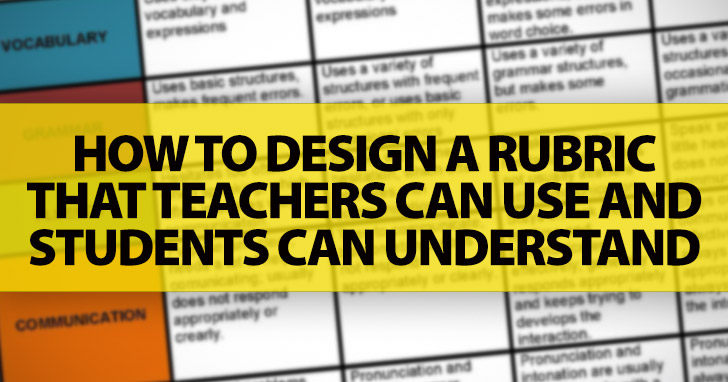How Much Did He Participate? Individual Grades for Group Discussion


A “rubric” is a grading standard which breaks down the grade into several categories: “excellent,” “good,” “fair,” and “poor,” for example, or a more traditional “A,” “B,” “C, and “D.” For each of these levels, there are a set of criteria related to writing such as organization, use of details, sentence structure, etc. The criteria are further refined at each level, so that an “A” grade the organization criteria might be described as “excellent organization with clear transitions that advances the purpose of the paper” while a “B” grade might have “clear organization with transitions related to the paper purpose,” showing with some details the differences between two levels based on one criteria.
Many departments and schools now have an expectation that rubrics be designed for each major assignment, with the idea, apparently, that rubrics will clarify expectations and result in fewer student complaints regarding grades. The problem is that rubrics often fail in their mission to clarify for both instructor and student the grading standards. Students, especially those earning poor grades, often view the grading standards suspiciously, seeing them as unfair and arbitrary; grading rubrics are no exception. However, there are ways to clarify grading rubrics and teach course expectations so that both students and teachers can understand and use rubrics effectively.

Rubrics, as with most tools that evaluate in some way, have inherent problems. Some of those problems are detailed below.
To someone outside the field of writing, for example, words such as “transitions” and “voice” and “controlling idea” and so forth sound foreign as they are part of a technical jargon the student is not familiar with, but the rubric assumes that familiarity.
An “A” is for an excellent paper; a “B” for a “good” one. What does that mean, exactly? What does an excellent paper look like? The language meant to clarify this difference fails to do so because in part the language can be difficult, as discussed above, to anyone outside of the field of study; often, also, the language and concepts are vague. What exactly does “excellent” mean in terms of writing?
A related problem to this vagueness of terms is the unclear differentiation between grades. When does organization stop being a “B” level “strong” and move into a C grade’s “formulaic”? The differences between two levels of grades and deciding that difference can be difficult for teachers, let alone students.
Overall, the main problem with a grading rubric is that it is grounded on the assumption of a deep understanding of the field that only specialists within it possess, which is why rubrics are typically designed by teachers with teachers in mind as an audience. We do the grading and are the ones who will use the rubrics for the purpose of grading, after all. But as many instructors give out the grading rubric now, either with the assignment itself or with the course syllabus, it is also important that students understand how these standards are applied to writing.

A major problem for novices in general is their unfamiliarity with the lingo of the field related to their recent entrance into the field and academic life in general and truly understanding the technical language. Grading rubrics are often replete with technical language of a discipline. Therefore, the teacher should be aware that she will have to clarify the terminology of the rubric when she introduces it. Showing clear examples of what makes a good “controlling idea” will go a long way in clarifying the rubric.
Showing examples of the largely abstract rubric applied to actual student work is important for complete understanding of it. What is the difference between an “A” and a “B” anyway? Well, better than talk in generalities about the dividing line between “excellent development” and just “good development,” the instructor can show examples from past student papers that demonstrate excellent development as opposed to just good.
With some training in understanding the language of the rubric and use of examples, students can develop a strong intuition about the difference between an “A” and a “B” paper. After some training in how to interpret and apply the rubric, students can be remarkably adept at assigning grades to sample papers, often hitting close to the assessment the instructor would have given. I have sometimes had students participate in mock “grading sessions” much like teachers participate in, “grading” past student work which have had names removed and which students have given prior consent to use. These kinds of grading sessions will occur after the beginning part of a term, after students have gotten to know each other, learned the rubric, and practiced working in groups. Often insightful discussion occurs in such sessions, with students supporting the grade they assign with clear rationale and coming to a reasoned agreement with each other.
The next step is to rate peers’ work. The week a paper is due, I have students work together, reading each other’s papers, and discussing their strengths and weaknesses. Again, training has already taken place in courteous discussion on how to use the rubric, and students are clear that they are responding as readers, how the paper works for them as readers rather than as teachers--they are not really assigning grades. Valuable peer feed back.
This is the hardest step off all. But after weeks of looking at sample and peer work, students are now trained enough to turn a more objective eye on their own papers. Especially if they have taken a “break” from them for a couple of days, students will now be able to turn a more trained eye on their own papers and pick out concerns in development and sentence structure, for example, that they hadn’t noticed before because they now have a stronger understanding of what good writing is. Techniques such as having students set the work aside for awhile, reading aloud, and visualizing their audience all help students develop the ability to self-edit and revise their own work in accordance with the standards set forth in the rubric.
Rubrics can be opaque and confusing, even to trained teachers. However, by teaching students the language of the rubric and discipline, providing examples of student writing at different levels, and applying the rubric to other students’ and their own work, students will develop a strong understanding of the rubric as well their understanding of good writing.